Part 38: Final Session: Peace
Final Session: Peace
Gentlemen, ladies. Congratulations are in order. We did it.
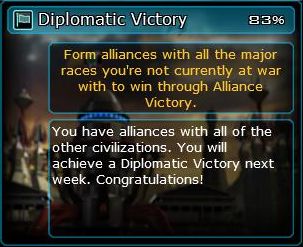

While the rest of the senate is downstairs awaiting the return of Svensgaard and the other heads of state from their galactic tour, I felt we could make one last report of the old senate. One last recording for posterity. There will not be as much to say, I admit, but we may not be here after the next elections, so I thought this would be our collective farewell to the old way.
Senator Morgan, I believe you traditionally started us off.
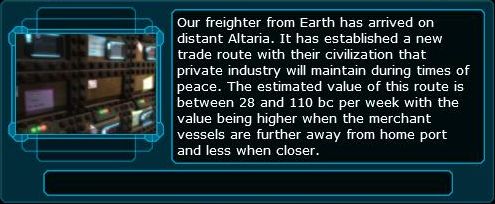
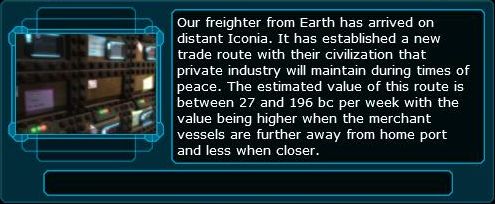
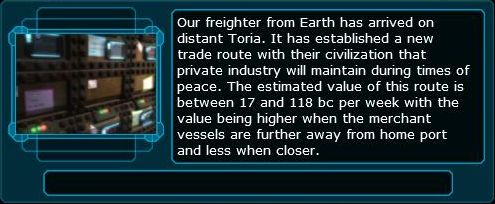

Trade is booming. Next?

That would normally be me, but I believe the diplomatic situation is important enough to save for last. Senator Zakharov, did you have anything to add?

Hmm? Oh, yes.


In approximately three weeks' time, star battleships will leave the design phase. That is all.

If things can continue as they have, we should be hard pressed to find a use for them. Senator Yang?
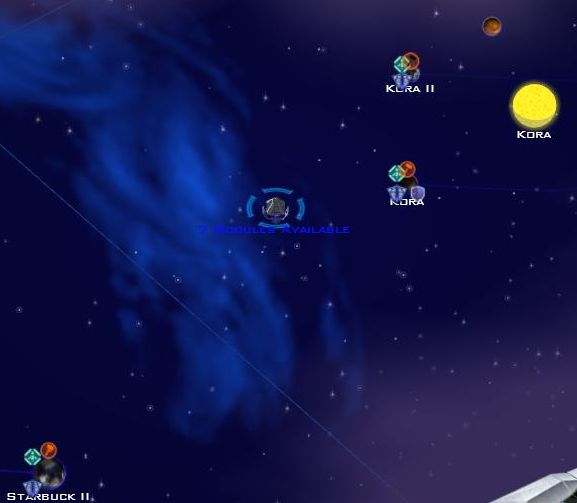

Our constructors continue to reinforce our starbases, although the exact figures seem to hardly matter at this juncture. I will mention that a new military starbase has been built adjacent to the Kora system. I believe it is quite near where the old Korathi base once existed.

I see. Senator Santiago, did you have anything to add?

Only that I was the one who ordered the starbase built.

Senator Skye, were there any particular projects completed?
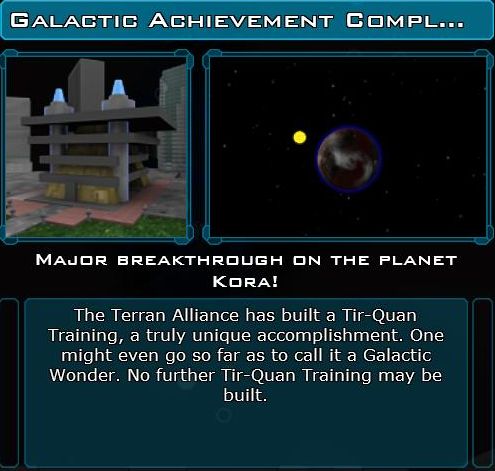

Yes, the Tir-Quan training facility was finished on Kora.

Very well. Is that everyone?

I have something to add.

Senator Godwinson? Please, go ahead.
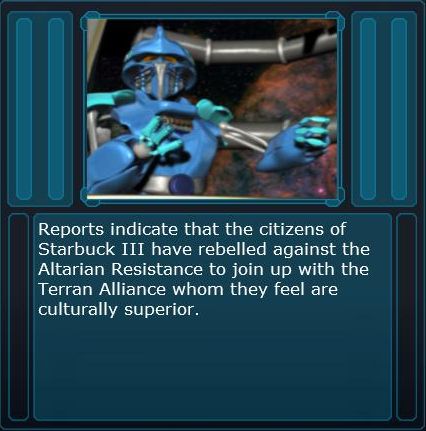
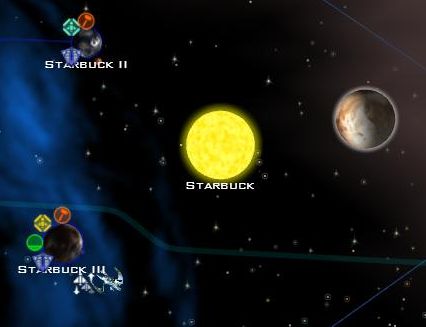

The citizens of Starbuck III have finally seen the light and have joined our Alliance.

I suppose the constant trading and visiting that went on between the two planets in that system had something to do with the matter. Very well, if that's everyone, I shall make my final report.
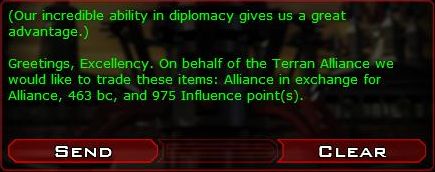

After the last session ended, I moved immediately to offer an alliance to the Drengin. They were all too happy to join with us, since they knew we would move to end the ongoing wars against them.

I should note that we also took the opportunity to give Morgan Mindworks Preferred Merchant status. Hopefully with the Drengin as addicted to Brainwavers as the rest of us are to holovids, their aggressive instincts will be blunted in the future.
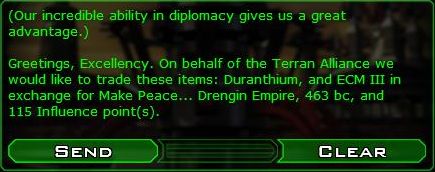

Regardless, we did negotiate treaties between the Drengin and the Torians and Altarians. The only missing element was the Yor.
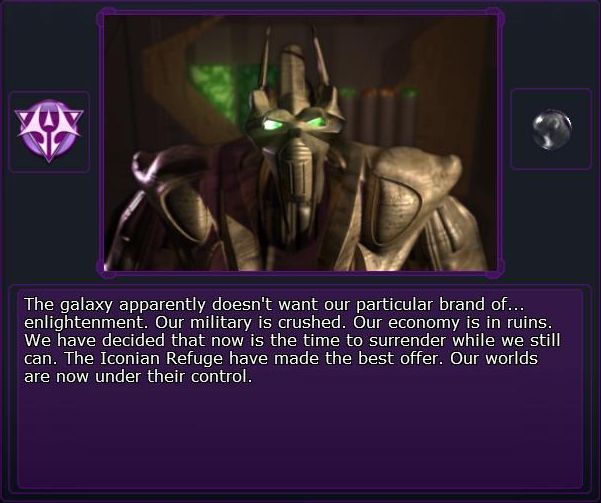

However, on April 22, 2233, the Yor declared their total surrender. Although the Torians wanted harsher conditions, given their losses in the war, the Iconians decided to forgive the Yor for what happened several million years ago. The Yor have permitted the Iconians to remove their xenocidal programming, and in exchange the Yor robots will be given full rights and citizenship in the Iconian Refuge. For the first time in millions of years, an Iconian will be able to walk upon its native soil.
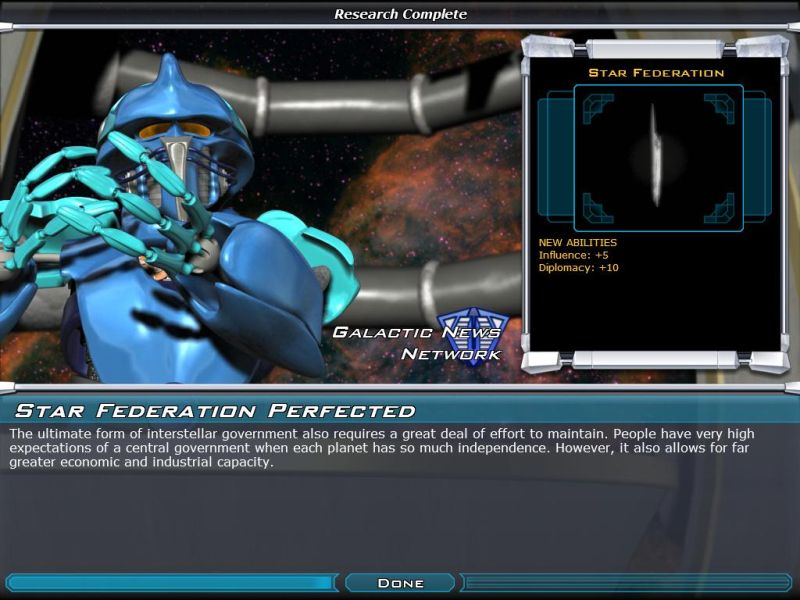

In domestic news, the allied Terran nations have agreed to grant the Stellar Senate a greater degree of control, even over Earth-based policies.

I would imagine the fact that the Alliance has several times more citizens than the Earthbound nations combined has something to do with the matter.

Yes, that is likely. But because of this move, the Terran Alliance has become, in effect, the Terran Federation. The senate's concession to the change is that now the upper house senators must now be elected to their positions by all their constituents. This brings us to why I called this special farewell meeting. I just wanted to-oh, pardon me. Yes, lieutenant?
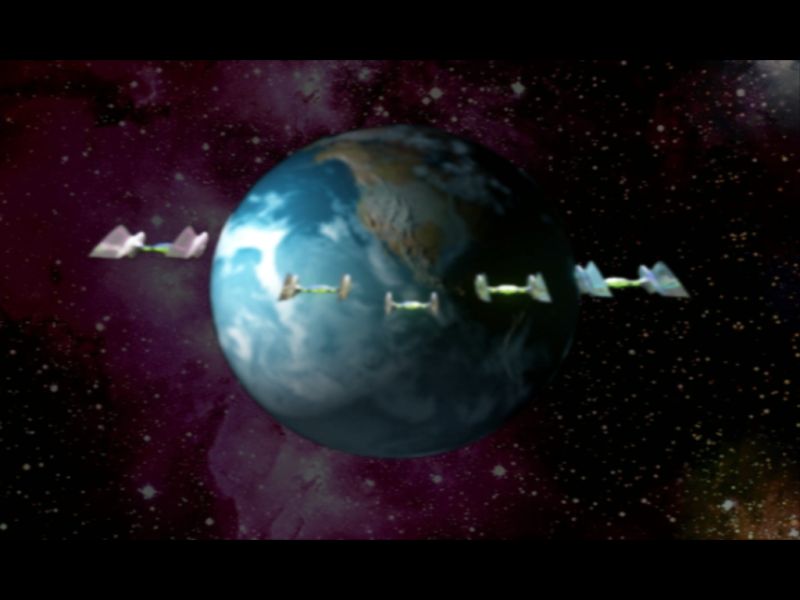

It would seem that President Svensgaard and the others are making their final approach to Earth now. I will try and wrap things up quickly.
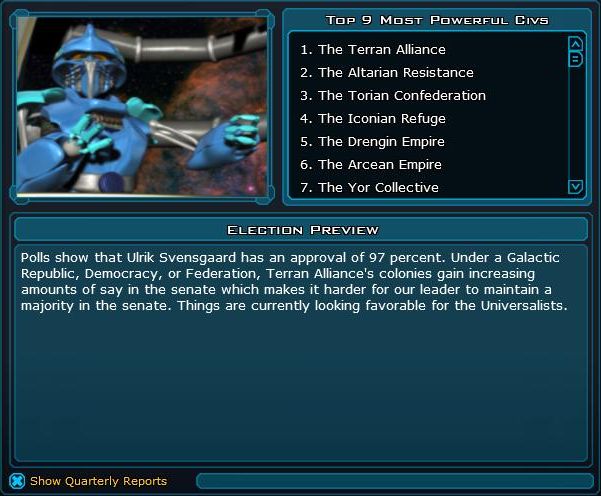

According to the latest graphs, we have been showing the most impressive numbers out of all our neighbors. I suppose we have Santiago's buildup to thank for that, but we have been pulling ahead on all fronts from what the numbers suggest.
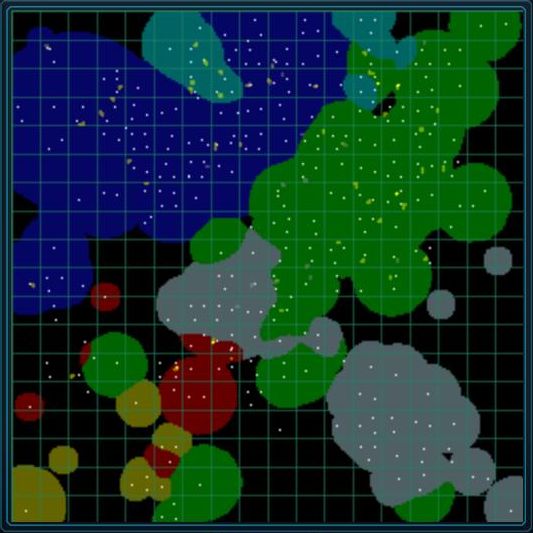

Even the size of our influence has begun to equal that of the Torians.

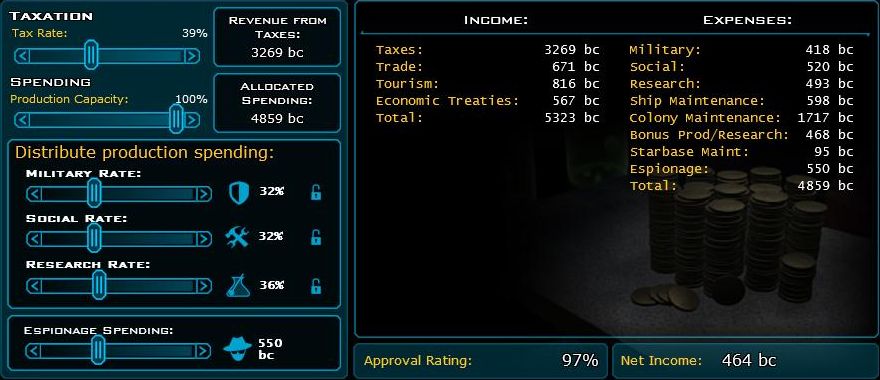

Our finances continue to do well. Not as well as the Torians, perhaps, but we aren't as willing to tax as much as they do.
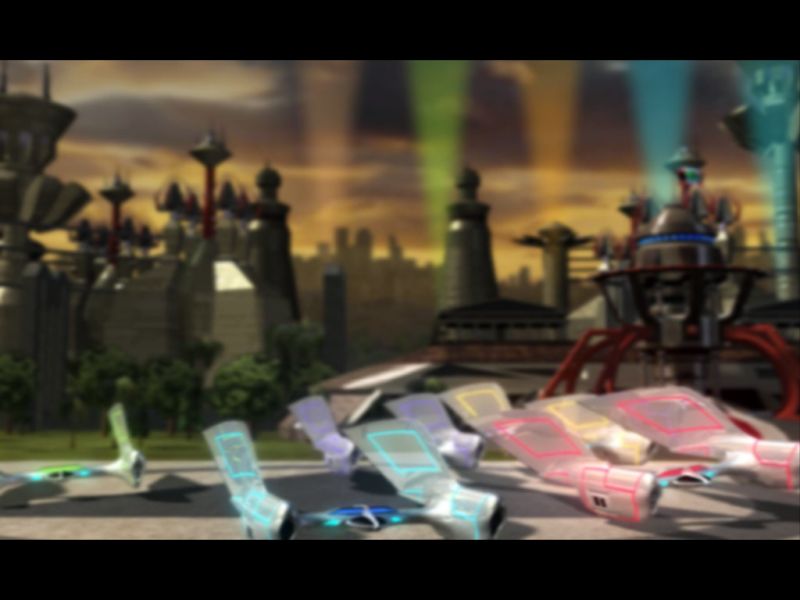


I would like to thank each and every one of you for making this happen, including those of you who are watching this recording. This would never have happened without everyone's support and political acumen.
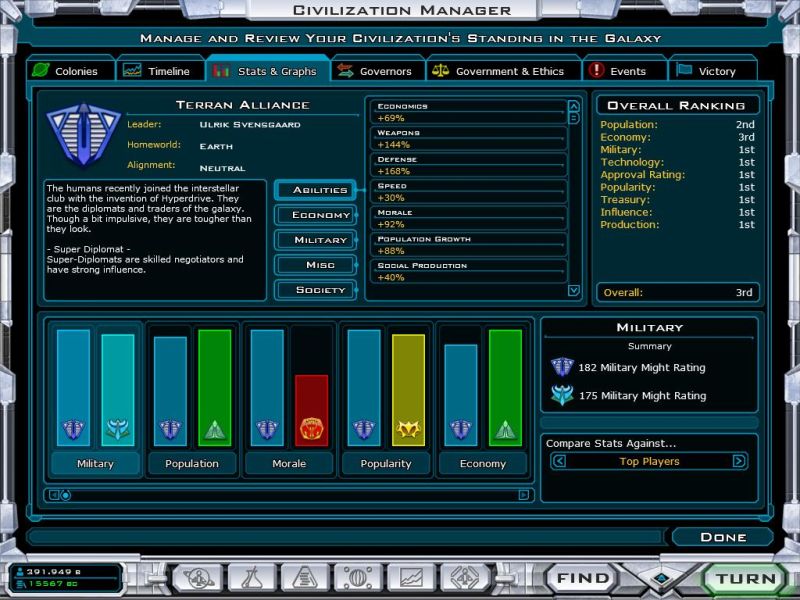
Final statistics for the Terran Alliance:
Economics +69%
Weapons +144%
Defense +168%
Speed +30%
Morale +92%
Population Growth +88%
Social Production +40%
Military Production +45%
Research +105%
Influence +136%
Trade +42%
Diplomacy +221%
Hit Points +60%
Repair +20%
Sensors +1%
Espionage +15%
Soldiering +75%
Purchase Now Reduction +25%
Trade Routes +11
Range +110%
Luck +50%
Courage +2%
Creativity +10%
Loyalty +1%
Logistics +36%
Miniaturization +40%
Population: 391.949 billion citizens
Approval: 97%
Colonies: 37
Unhappy Colonies: 0
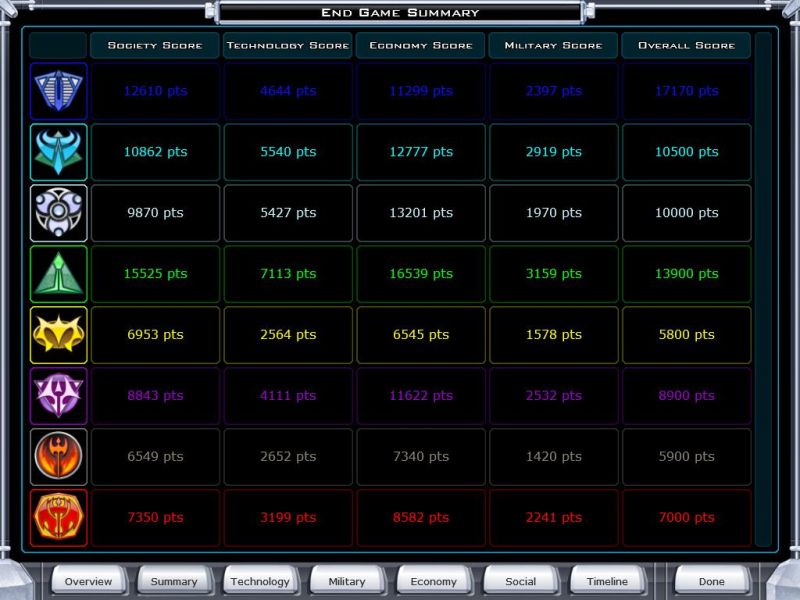
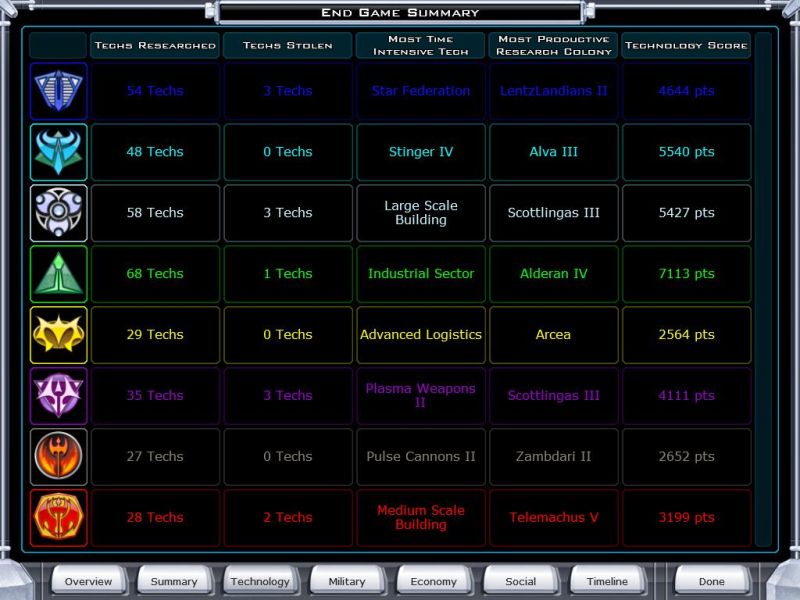
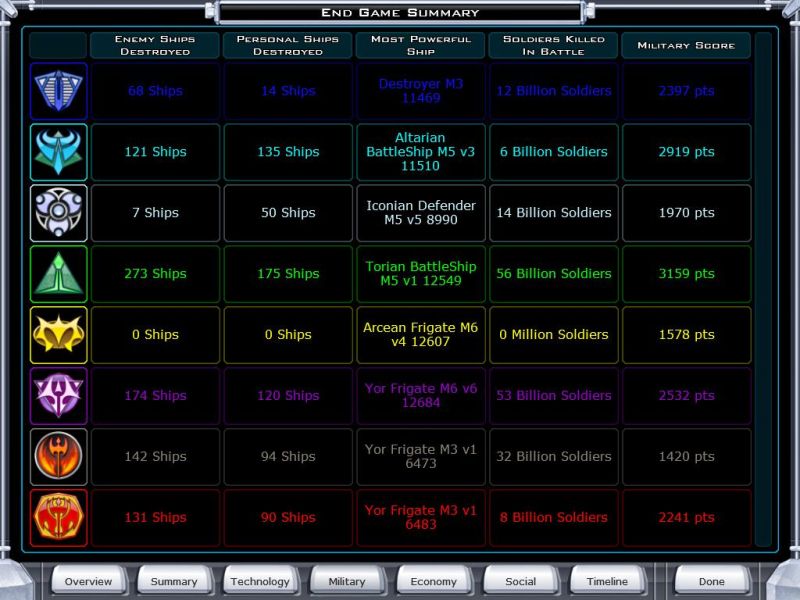
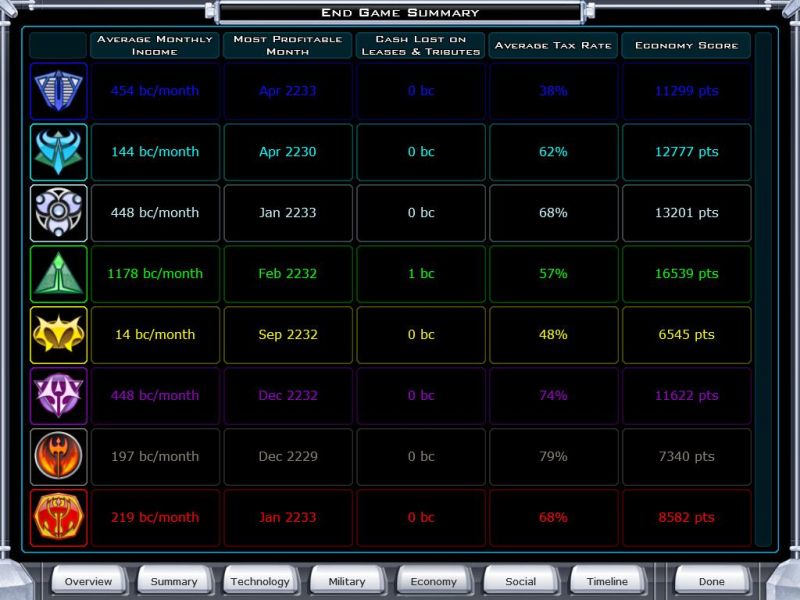
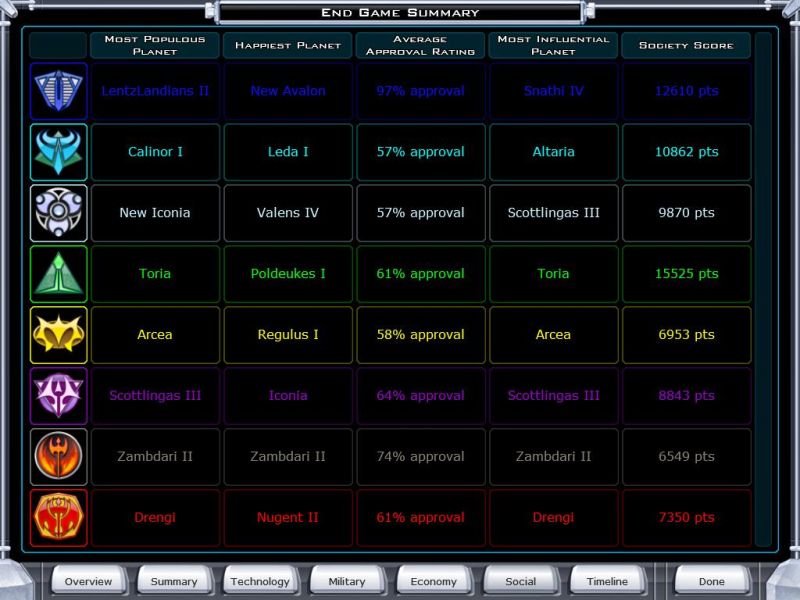
By the total numbers you see here, it would seem that we didn't manage nearly so well as the Torians did, on basically every front. However, the line graphs tell a different story.
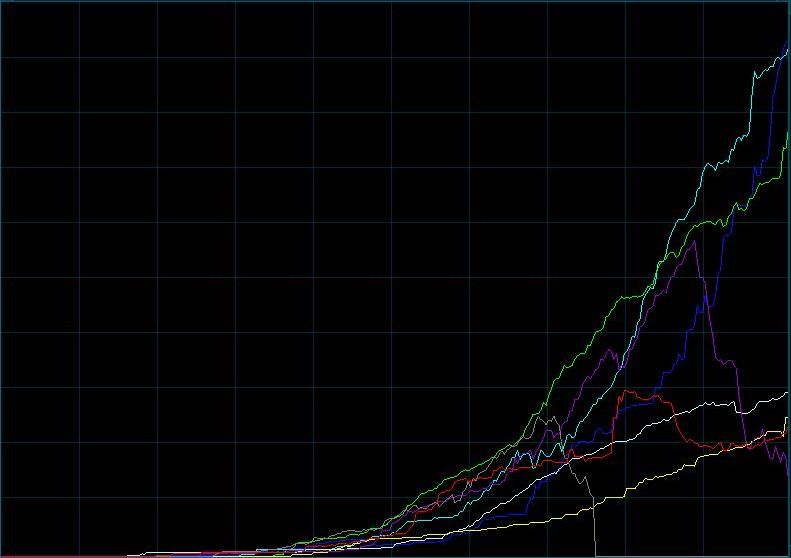
Graph one is the military. You can see quite clearly when the Torian-Yor war was declared, and how it didn't go so well for the Yor. Perhaps we wouldn't have caught up to the Torians if they weren't losing ships against the Yor, but by the very end there, you can see where we managed to bypass the Altarians, who weren't sending nearly as many ships to get blown up by the Yor. Down lower, you can see the point at which someone declared war against the Drengin; their special ability is Super Dominator, which gives them a set of free ships when war is declared. Looking at the graph, though, the extra ships obviously didn't help.
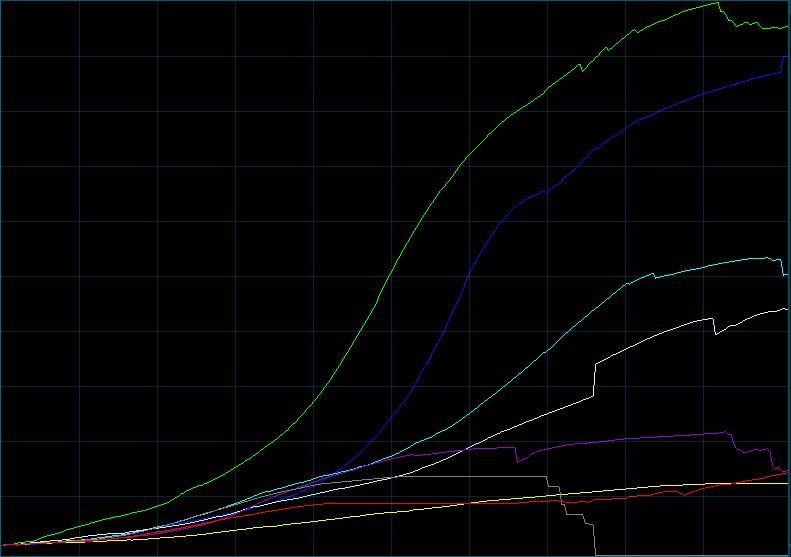
This is the population graph. As you can see both from this and from the "soldiers killed" numbers above, the Yor evidently gave as good as they got when it came to fighting the Torians planetside. Of course, one should also compare the absolute numbers: the Torians barely felt their losses, while the Yor were down nearly a third from their high point.
One other thing to note is to compare the Torian losses here with the minor divot the Terran population hit when wiping out the Korath Clan. Even with all their advantages, Torians don't make nearly as good soldiers as Terrans do.
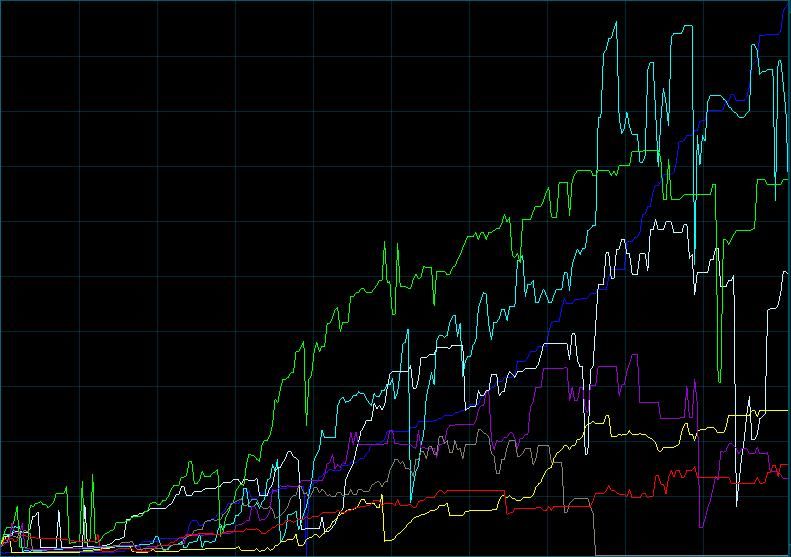
Research here is a bit more chaotic, probably influenced by the AI micromanaging planetary foci and spending levels. If you watch the blue line, though, it's apparent that slow and steady wins the race. We didn't screw around with focusing on specific projects or futzing around with spiking research levels, we just built up the planetary improvements until we finally hit a level beyond even the highest of Altarian spikes.
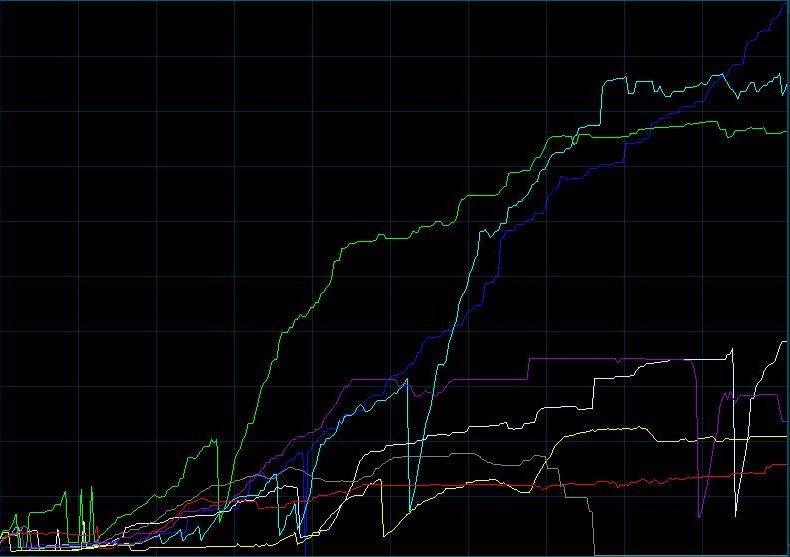
The same goes for manufacturing. Other civilizations may have built fast and early, making a logarithmic curve, but the Terrans kept at it in a rough line, growing slowly but steadily up to a still-unreached height.

This final graph shows influence levels. Here there really was a spike in Terran influence. Partly it's because I started building influence bases at that point, but I'm pretty sure it's mostly because I started buying Iconian influence technologies. You'll notice that there's a pretty big spike in Iconian influence just before the Terran spike. The reason the Terran spike is bigger is simply because, since influence operates on a percentage basis, we had a higher baseline to begin with.

It's hard to believe we've come so far in such a short time span, isn't it? And yet here we are, bringers of a new age to the galaxy and architects of the grand peace. And now all the fighting is finally over.

For now.

Oh, don't be so negative. I realize that this peace probably can't last forever, but we've managed this much, we should be proud of ourselves.

I'm not being negative. It's simply that there's the rest of the galaxy to consider.

But we just made peace with the rest of the galaxy.

Hardly. We made peace with our stellar neighbors, certainly, but not the rest of the galaxy.

But-the map-

*Sigh* You think I would know better by now, but the inability of humans to grasp truly large numbers keeps astounding me. Here, let me create a visual aid for you.
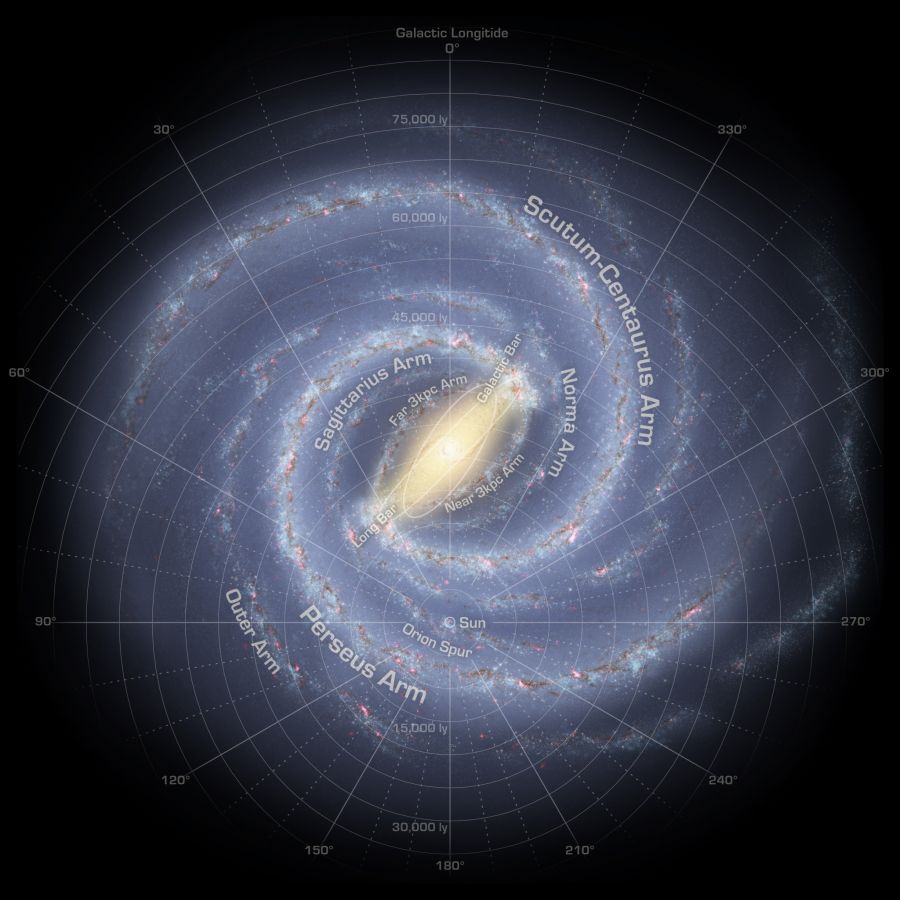

This is the Milky Way as we understand it today. Do you see that tiny circle labeled "Sun?" We have successfully charted most of the space within the area of that circle.

Then why the map? Why that size?

That's the Gould Belt. Most stars not on the map are several times farther out than the most distant star within the Belt. Of course, as we develop more efficient life support systems and faster warp drives, we may one day be able to reach outside of the Belt. Indeed, if we continue research at this pace, we might reach the main Sagittarius Arm within a hundred years.

But there are 165 known planets already!

That sounds about right, particularly since approximately one third are marginal planets we can only settle thanks to advanced terraforming technology. Look, life is a lot more inevitable than some people seem to think. If you take any second generation main sequence star between a time span billions of years wide, chances are better than equal that it will have at least one rocky planet with the necessary ingredients to host mobile self-replicating organisms. Life! And as we've seen for ourselves, life can find a way in far less ideal circumstances, like binary systems or nebulae. One hundred and fifty planets in our immediate surroundings, along with a handful of sophonts who originated hundreds of thousands to millions of years apart from each other, sounds fairly likely to me, especially considering the number of stars involved. Really, the most unlikely aspect is how most of them managed to stagnate at approximately the same tech level until we came around.
Something you must understand is the numbers involved. There are more stars in the Milky Way than there are grains of sand on every beach on Earth, and there are just as many galaxies in the universe as there are stars in the Milky Way. Do you know why space was once called the final frontier? Because it has no conceivable end. Even with humanity scattered across dozens of planets, there is unlimited room for expansion.

Here. You wanted the most secure room in the buildin', and this is it. Oh, hey guys.

Ulrik, do you trust the people present here? Do you completely trust them?

…Hmm. Guards, hey. Outta earshot. Zak, recorder.

Computer, record the following in Omega encryption. Security is my brainscan only.

Best we can do. So, Tlas, what's the big deal?

I apologize for not telling you sooner, but I have reason to believe that even our most secure transmissions are compromised, and a trip to Terra under normal circumstances would be noticed. You recall the galactic sabotage attack from several years ago, of course. And you must recall that the instigators were never found? Well, while you and the other species were purging your planets of the infiltration, we decided to keep some around, to trace the source of the spies. It wasn't easy turning them, and I'm still not certain that we're not being fed information, but we have gathered some very important information.
First, we believe that all of our governments are still compromised, up to the highest levels. The attack was nothing more than a test, a show of power. The aliens responsible appear to have some shapeshifting abilities, although we're not sure if it's inborn or technological, but this does explain their excellence at espionage.
The spies call their nation the Drath Legion, and their natural appearance is reptilioid. And before you ask, I have checked this data with President Mue: she confirms that they appear to be the species which disappeared from Altaria during their prehistory.

Do we know where they are based?

No. It seems likely they are from outside the Gould Belt, based on their statements, but this would be deeply troubling. To send this many individual agents through such a void under such secrecy…how powerful could they be?

Heh, go figure. Always a bigger fish.
Fifty years and a week ago, the very first human saw Earth from above. Eight years later, the first human stepped upon foreign world. Since then, it has never been a question of if, but when we return, and of what we will find out there among the stars…